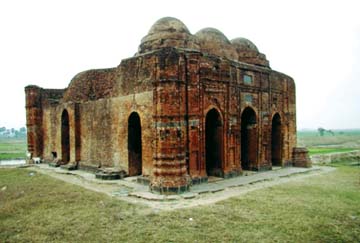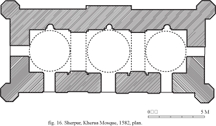Kherur Mosque
Kherur Mosque a mosque of Husain Shahi period on top of a mound, roughly three metres in height and covering an area of two acres in the northeastern corner of Kherur village within the jurisdiction of Sagardighi Police Station of Murshidabad district, West Bengal, India. The village, variously called Kherur, Kherul or Kheraul, is about five kilometres southeast of Sheker Dighi between Berhampore and Farakka.

According to the two dedicatory inscriptions in Arabic now affixed to the mosque, one with the name of the reigning sultan and the other without, the mosque was built by one Rafat Khan in 900 AH (1494-95 AD) during the reign of Sultan Alauddin husain shah (1494-1519 AD).
The covered rectangular structure of this mosque, consisting of a single domed prayer chamber and a triple domed corridor with four minarets at four corners, is constructed entirely of brick without any stone facing. Stone fragments, probably quarried from an earlier structure, were however reused as lintels, pillars and pilasters in the corridor and the prayer chamber. The hemispherical dome of the main prayer chamber fell down in the earthquake of 1897, but the three small domes of the corridor in front are more or less intact. The minaret on the northwestern side has been entirely destroyed, but the remaining three are preserved in a somewhat damaged and truncated state.

The mosque is entered from the east through the three arched openings of the pillared corridor leading to the main prayer chamber which measures nine metres approximately in length and breadth. The corridor, as well as the prayer chamber, has two subsidiary openings on the northern and southern sides. The qibla walls bear three semicircular prayer niches, the central one being bigger than the other two. The mihrab on the southern side is well preserved but the central and the northern mihrabs have been damaged. The ornamental scheme of the mosque, for which it is notable, is made up almost entirely of brick except for eight pilasters, which are of stone.
The mosque belongs to the square domed type of pre Mughal mosques with a corridor in front, a type which evolved during the later Ilyas Shahi period of the Bengal sultanate and examples of which can be found in the Chamkathi, Lattan and Rajbibi mosques at Gaur; Gopalganj, Sura and Rukn Khan's mosques at Dinajpur; masjidbari mosque at Patuakhali, etc.
The qibla wall bears exquisite and delicate brick relief works recalling similar decoration in the dhunichawk mosque at Gaur. The west exterior wall has triple horizontal mouldings with intricate designs at the base and richly embellished panels above. Similar panelled decoration in terracotta is still extant on the inner north and south walls and the left side of the facade. Traces of carved brickwork can be found on a lesser scale around the other exterior walls. The ornamental scheme comprise mainly of floral designs in which rose predominates.
The two dedicatory inscriptions of the mosque in Arabic were found lying loose inside the brick terrace of the tomb of Ghazi Pir Kalla near the mosque by T Bloch (1905) and were subsequently affixed to its facade in course of conservation work. The mosque is a protected monument of the Archaeological Survey of India.
Archaeological explorations conducted in 1992 around the mound and near a pond excavated in its northern edge yielded sherds of black and red ware (of chalcolithic association); grey and buff ware; iron slag; microlithic debitage (in quartz); Gupta and post-Gupta bricks (4th-7th century AD); and a Pala period (8th-12th century AD) oblong boundary marker in black stone. An image of Visnu in black stone of the Pala-Sena period was also reported to have been found from the village in 1978. These archaeological evidences indicate that the place was under human habitation more or less continuously from the Proto-historic period. [Pratip Kumar Mitra]
Bibliography AH Dani, Muslim Architecture in Bengal, Dacca, 1961; BK Bandyopadhyay and AK Bandyopadhyay, Pashchim Banger Purasampad Murshidabad (in Bangla), Calcutta, 1982; CB Asher, 'Inventory of key monuments' in George Michell (ed), The Islamic Heritage of Bengal, UNESCO, Paris, 1984.
